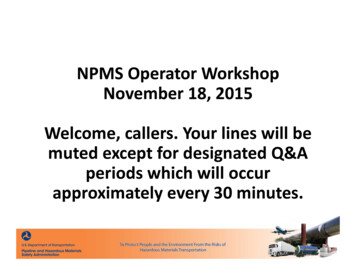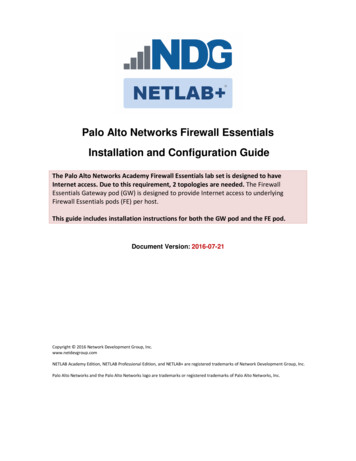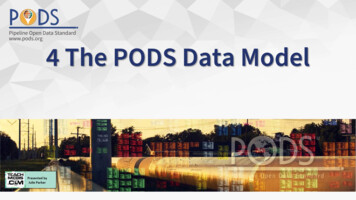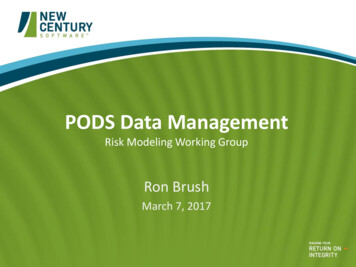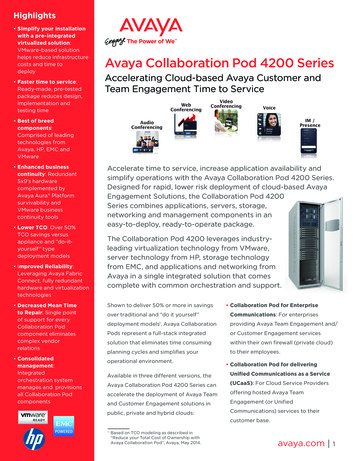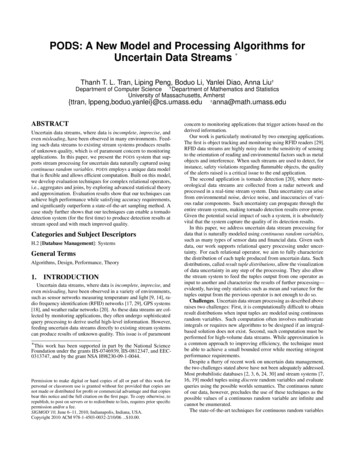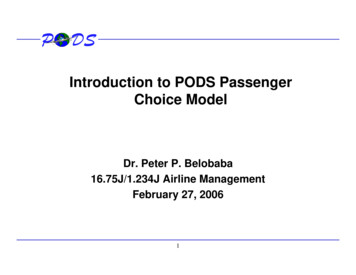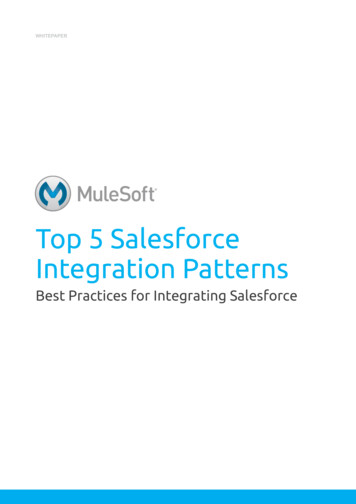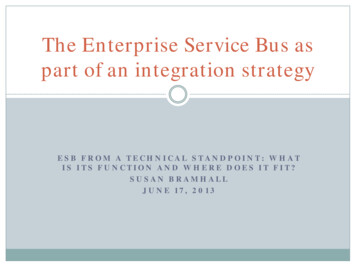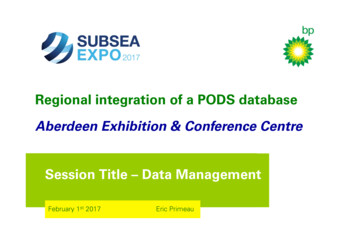
Transcription
Regional integration of a PODS databaseAberdeen Exhibition & Conference CentreSession Title – Data ManagementFebruary 1st 2017Eric Primeau
Presentation Purpose“The focus of this presentationis to highlight the processes,resource, knowledge base,architecture and infrastructurerequired for a successful PODSimplementation”.2
Office Harmony / Performance Recognition Seriously – Are you just digging ahole for yourself?“It will cost a Fortune ”“Take ages to deliver ”“Just sit on the shelf!”YouProcurementYour Boss3
Why Change? Simplification & Efficiency? Modernising & Transforming? Cost Reduction? Regaining ownership of data? Regaining control over data? Improving access to (your own) data?4
Why Change? Original design purpose Original design life Collaboration (OGA) Decommissioned Pipelines Change of ownership ‘MOT’ for your pipeline Vendor neutral (PODS)There must be a reason to change an established process5
Decision processIf your company migrates to PODS, it is a longterm decision and will completely change theway both you and your company managepipeline spatial & integrity data.Existing corporate structure is liable to re-align,necessitating the development or hire of newskill sets and establishment of new reportinglines (for example, essential knowledge ofRDBMS/S - SQL / Oracle).Significant IT co-operation will be required.6
Hows’, Whys’ and Wherefores? Engineeringproperties Physical properties of the pipeline Year on year inspection data ILI, GVI, GI DVD / Video / stills footage Space Hog! Do not underestimate the space requirement/ cost of video storage.Where is all this data?**Rationalise and migrate**7
Challenge Sourcing and accessing data Preparing for migrationHOW to migrate? Invest in infrastructureand personnel Get someone elseto do it!? Magic Button? (NOT)8
OptionsDo it In-house:Outsource: Contractor Strategy Strategy Management buy in Management buy in Access to data Access to data Finance Finance Organisation Organisation Resource Resource Architecture Architecture9
ContractorFirst – Find one!BP have utilised two companies to assist withPODS deployments globally to date:One based in VancouverOne based in Kansas CityObvious conflict of interest with existingintegrity management houses – one of theunderlying ideologies of PODS is to retain dataand IM process internally.10
ContractorLevel of engagement: Consultancy Guidance & Training ‘Simple’ data mining, rationalisation & migration Ongoing ‘Year on Year’ migration Hosting GIS Hosting analysis tools Managing corporate integrity program . Long term relationships11
InitiationMEETINGS .! Planning Start-up Kick-off RolloutThese will take up a LOT oftime, but if anyone in the loopfeels they are not informed . Update Weekly Monthly Cake12
Define StrategyA detailed development strategy outlining: COST estimates Delivery timeline Stakeholder engagement Access to source data Archived engineering & Inspection data As Built data Hardware Servers ArcSDE (ArcServer) is essential for the multi-user deploymentof a PODS model and delivery of web-based mapping. Software ArcGIS / Pipeline Office Studio (PLOS) / ESRI Portal / Geocortex People Operations & Integrity Engineers GIS Specialists / Database Specialist / Administrator Data Entry personnel13
Beginning .More MEETINGS .!14
15
Why PODS?http://www.pods.org/ The PODS Association is a not-for-profit, vendor-neutral, pipeline data standards association. Theassociation was created to develop and maintain open data storage and interchange standards tosupport the needs of the pipeline industry PODS (Pipeline Open Data Standard) is a database schema Schema - the structured organization of data to create a blueprint of how a database will beconstructed - divided into database tables Each table within the database is in a specific format that is universally recognized16
PODS Relational Data Model DiagramExample data set:Abbreviated “Anode”table under CathodicProtection category17
PODS Data Dictionary - Anode (Pages 17-21 out of 1084)Data Dictionary specifiesexact format of data field(Alpha Numeric SpaceCharacter) as well asdescription of field.18
PODS Positives Global data standard governed by association Standard means same format and structure of datais used worldwide Scalable and adaptable Highly detailed Base PODS Model and schema easy to implement Copes with land-based pipelines, offshore pipelinesand a mix in one database19
PODS Negatives Overly complex in current “standard” format Steep learning curve for non-engineers and non-GISprofessionals alike Poor interface with ArcGIS Portal to publish onlinemaps due to number of relations extant Third party data loaders can be inconsistent andbug-prone Relationships between tables not always obvious Relationships not always handled well by ArcGIS No global symbology style in place Only one PODS instance per Server install (morethan one causes issues due to relations clashing)20
Relational Database - complexity A Relational Database links tables using Globally UniqueIdentifier (GUID) whereas a Spatial database contains all thedata required for (an event) in a single table (eg co-ordinates). Software used to maintain relational databases are known asRelational Database Management Systems (RDBMS). Virtually all RDBMS use SQL (Structured Query Language) forquerying and maintaining the database. The route centreline is created once. Many pipeline segmentsmay be compiled in a single Station Series table with eachsegment assigned a GUID. Each event (anode etc) will be associated with the SegmentGUID, and will have a unique Event ID The position of an event will be defined by either or both of a‘Station’ or ‘Measure’ value. A pipeline segment may be simply 2D KP developed, or 3Dbased on engineering and installation records. The ‘station’ may be used to define the KP of the event. The ‘measure’ value may be true physical distance of the event.21
Core truth“Creating a PODS dB islargely a data mining andsyntax exercise!”22
Playbook Process Identify pipeline segments requiring migrationDevelop segment centrelines in 3D (Measure Values)Develop segment centrelines in 2D (Station Series)Identify which PODS tables requiredIdentify required fields in the tablesPopulate Excel spreadsheetsQC – Check table content and syntax – Align with Data DictionaryCollaboration on structure of GIS and implementation supportCollaboration during migration from spreadsheet to database via PLOSConstruct a ‘Baseline’ database (Centerline & As-Built Features)Inclusion of additional GVI and ILI data (Year on Year inspection data)Work with sub-contractors to determine future PODS requirements fordata delivery (GVI / ILI / Acoustic results) in data delivery process Big projects Big data Long pipelines, many years inspection data Big Data Video Data Big Data23
Example Workflow:Data file(PRISM)EXCELinputPLOSdataloaderProcess and challenges: Measure value vs Station value PLOS does not accept –ve values for measureAccess mdbin PLOSPLOSOutputto ArcGIS Frequently station series based on 2D KP value KP0 frequently at SSIV -ve KP along spool – riser – topside pipework.24
Pipeline Office Studiowww.geonamic.com Designed as an analytical browsing and reporting tool for PODSdata Creating EXCEL templates, populating and uploading to schema Creates and manages GUIs through process New Co. low resources. Beta testing product. Slow turnaroundon recognising & resolving problems. Improving steadily.25
Turboroutewww.eaglemap.com Turboroute Alignment sheet generator Eagle Information mapping Inc. product26
Server Specifications (BP specification)Staging and Production servers: Located in NSHQ Computer Room, data backed up in EMDC Server Specification : Dell R720, 2*4 Cores ( 8 total), 512 GB RAM, IntelXeon E5-26433.30GHz, 10M Cache, 8.0GT/s QPI, Turbo, 4C, 130W,DDR3-1600MHz, on RHEV – SPECint2006 617 (per core 51.4) Supports around 536 concurrent users at 80% server utilization Oracle 11g base 1.5TB storage, expandable Upscaled from base recommendation for PODS usage - upscaleincludes Pipeline Office Studio, and Turboroute ArcGIS Server 10.4 utilised on this server - on desktops it is ArcGISDesktop 10.3.1 until Q2 2017, when it will be upgraded to ArcGIS Pro. Cost approximately 40K purchase & installation (not including software) Software suites operated under enterprise licenses.27
Strategy, Implementation & Instructions28
Viewing PODS data GIS29
Accessing a feature30
Review Anode Information31
Review Anode Information32
BP Instances Azerbaijan, Georgia, Turkey (AGT) Trinidad Angola North Sea Gulf of MexicoNo region is fully mature and all are still under various levels ofdevelopment.Current climate has restricted development due to funding &resourcing challenges.33
PODS Summary The PODS data model is implemented on a relational databasemanagement system (RDBMS) such as Oracle or SQL Server. Queriesand interactions with the PODS database are written in structuredquery language (SQL), the most common database programminglanguage. The PODS relational model does not depend on GIS, but a GIS is themost common method for displaying PODS data. PODS is ‘GIS‐platform independent’, meaning it can work with ESRI,Intergraph, or any other GIS software. Building and maintaining a PODS compliant pipeline GIS is aninvestment in gathering and maintaining quality data, creatingmanageable workflows, building and supporting software. Since the data records are linked to the pipe segment, re-route, changeof service, asset transfer or sale, abandonment, removal, repair, andreplacement are all managed within the PODS database. A PODS compliant database WILL increase the value of your asset A PODS database WILL reduce risk through increased Pipeline IntegrityManagement features34
Conclusion Developing and managing a PODS Database is expensive, timeand resource consuming. Development & management is a long term proposal requiringcollaboration between Geomatics, Operations and IntegrityManagement. Managing data and integrity of pipelines internally willeventually save costs, so long as your company commits, isaware of timelines / requirements and maintains this approachthroughout the development and delivery process. There is very little external PODS consultancy support in UK. OPPORTUNITY!35
Questions?
The PODS relational model does not depend on GIS, but a GIS is the most common method for displaying PODS data. PODS is ‘GIS‐platform independent’, meaning it can work with ESRI, Intergraph, or any other GIS software. Building and maintai
